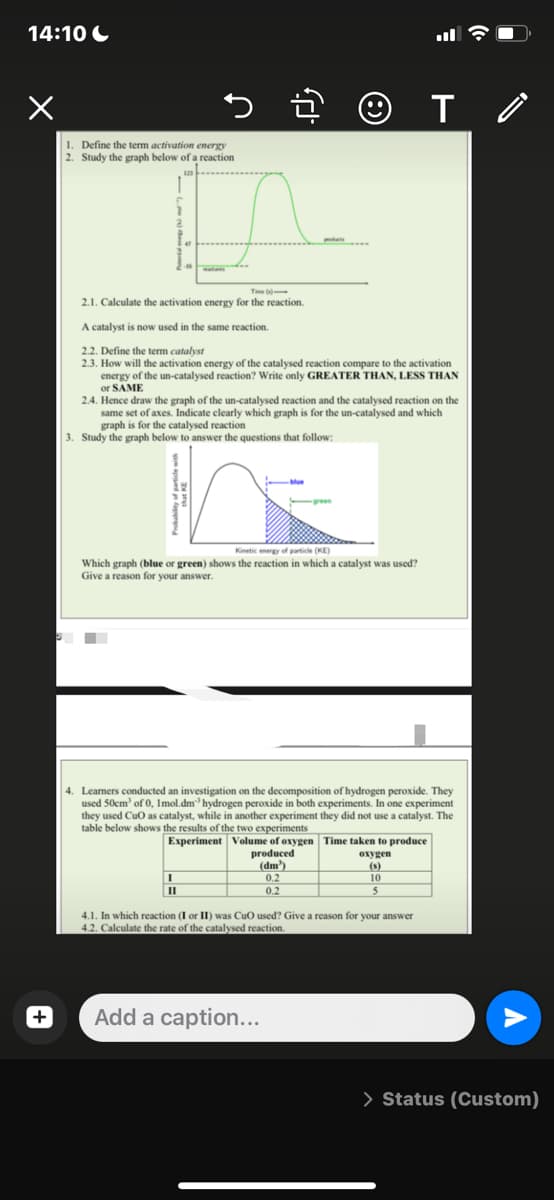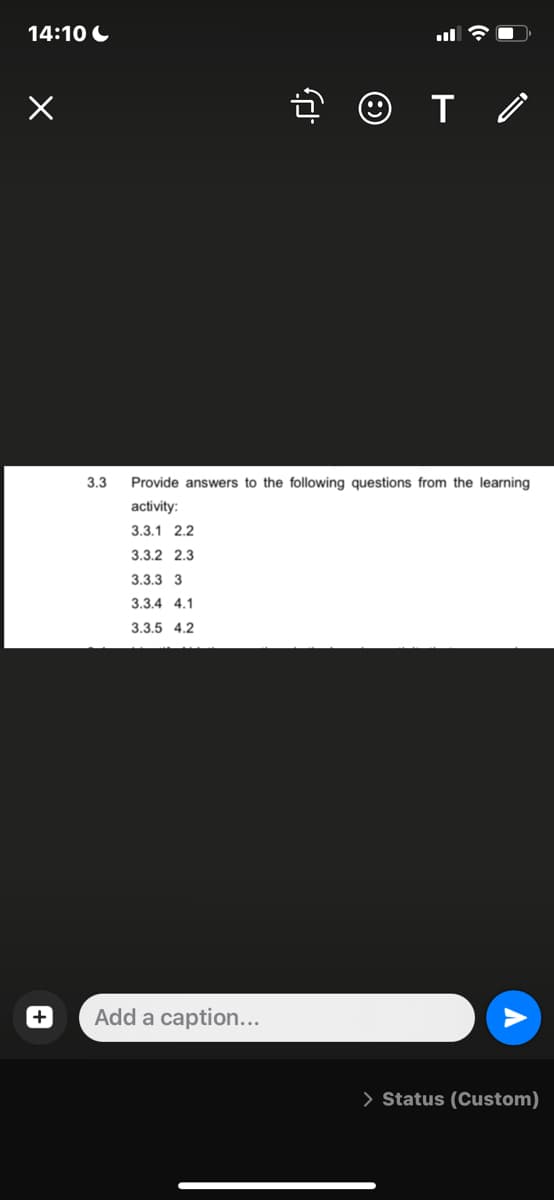1. Define the term activation energy 2. Study the graph below of a reaction 121 2.1. Calculate the activation energy for the reaction. A catalyst is now used in the same reaction. 2.2. Define the term catalyst 2.3. How will the activation energy of the catalysed reaction compare to the activation energy of the un-catalysed reaction? Write only GREATER THAN, LESS THAN or SAME 2.4. Hence draw the graph of the un-catalysed reaction and the catalysed reaction on the same set of axes. Indicate clearly which graph is for the un-catalysed and which graph is for the catalysed reaction 2) Ban 1.
1. Define the term activation energy 2. Study the graph below of a reaction 121 2.1. Calculate the activation energy for the reaction. A catalyst is now used in the same reaction. 2.2. Define the term catalyst 2.3. How will the activation energy of the catalysed reaction compare to the activation energy of the un-catalysed reaction? Write only GREATER THAN, LESS THAN or SAME 2.4. Hence draw the graph of the un-catalysed reaction and the catalysed reaction on the same set of axes. Indicate clearly which graph is for the un-catalysed and which graph is for the catalysed reaction 2) Ban 1.
Chemistry: The Molecular Science
5th Edition
ISBN:9781285199047
Author:John W. Moore, Conrad L. Stanitski
Publisher:John W. Moore, Conrad L. Stanitski
Chapter11: Chemical Kinetics: Rates Of Reactions
Section: Chapter Questions
Problem 11.ACP: (Section 11-5) A rule of thumb is that for a typical reaction, if concentrations are unchanged, a...
Related questions
Question

Transcribed Image Text:14:10
x
+
T /
1. Define the term activation energy
2. Study the graph below of a reaction
Time (1)
2.1. Calculate the activation energy for the reaction.
A catalyst is now used in the same reaction.
2.2. Define the term catalyst
2.3. How will the activation energy of the catalysed reaction compare to the activation
energy of the un-catalysed reaction? Write only GREATER THAN, LESS THAN
or SAME
2.4. Hence draw the graph of the un-catalysed reaction and the catalysed reaction on the
same set of axes. Indicate clearly which graph is for the un-catalysed and which
graph is for the catalysed reaction
3. Study the graph below to answer the questions that follow:
Kinetic energy of particle (KE)
Which graph (blue or green) shows the reaction in which a catalyst was used?
Give a reason for your answer.
■
4. Learners conducted an investigation on the decomposition of hydrogen peroxide. They
used 50cm³ of 0, Imol.dm hydrogen peroxide in both experiments. In one experiment
they used CuO as catalyst, while in another experiment they did not use a catalyst. The
table below shows the results of the two experiments
Experiment Volume of oxygen
Time taken to produce
oxygen
produced
(dm³)
(s)
0.2
10
11
0.2
5
4.1. In which reaction (I or II) was CuO used? Give a reason for your answer
4.2. Calculate the rate of the catalysed reaction.
Add a caption...
> Status (Custom)

Transcribed Image Text:14:10
X
+
+
T/
Provide answers to the following questions from the learning
activity:
3.3.1 2.2
3.3.2 2.3
3.3.3 3
3.3.4 4.1
3.3.5 4.2
Add a caption...
> Status (Custom)
3.3
Expert Solution
This question has been solved!
Explore an expertly crafted, step-by-step solution for a thorough understanding of key concepts.
Step by step
Solved in 5 steps with 2 images

Knowledge Booster
Learn more about
Need a deep-dive on the concept behind this application? Look no further. Learn more about this topic, chemistry and related others by exploring similar questions and additional content below.Recommended textbooks for you

Chemistry: The Molecular Science
Chemistry
ISBN:
9781285199047
Author:
John W. Moore, Conrad L. Stanitski
Publisher:
Cengage Learning

General Chemistry - Standalone book (MindTap Cour…
Chemistry
ISBN:
9781305580343
Author:
Steven D. Gammon, Ebbing, Darrell Ebbing, Steven D., Darrell; Gammon, Darrell Ebbing; Steven D. Gammon, Darrell D.; Gammon, Ebbing; Steven D. Gammon; Darrell
Publisher:
Cengage Learning

Chemistry for Engineering Students
Chemistry
ISBN:
9781337398909
Author:
Lawrence S. Brown, Tom Holme
Publisher:
Cengage Learning

Chemistry: The Molecular Science
Chemistry
ISBN:
9781285199047
Author:
John W. Moore, Conrad L. Stanitski
Publisher:
Cengage Learning

General Chemistry - Standalone book (MindTap Cour…
Chemistry
ISBN:
9781305580343
Author:
Steven D. Gammon, Ebbing, Darrell Ebbing, Steven D., Darrell; Gammon, Darrell Ebbing; Steven D. Gammon, Darrell D.; Gammon, Ebbing; Steven D. Gammon; Darrell
Publisher:
Cengage Learning

Chemistry for Engineering Students
Chemistry
ISBN:
9781337398909
Author:
Lawrence S. Brown, Tom Holme
Publisher:
Cengage Learning

Chemistry: Principles and Reactions
Chemistry
ISBN:
9781305079373
Author:
William L. Masterton, Cecile N. Hurley
Publisher:
Cengage Learning


Chemistry
Chemistry
ISBN:
9781305957404
Author:
Steven S. Zumdahl, Susan A. Zumdahl, Donald J. DeCoste
Publisher:
Cengage Learning